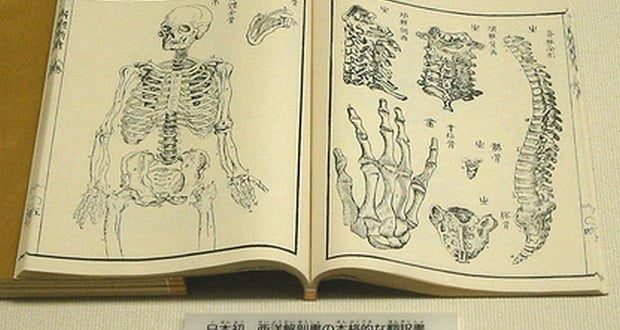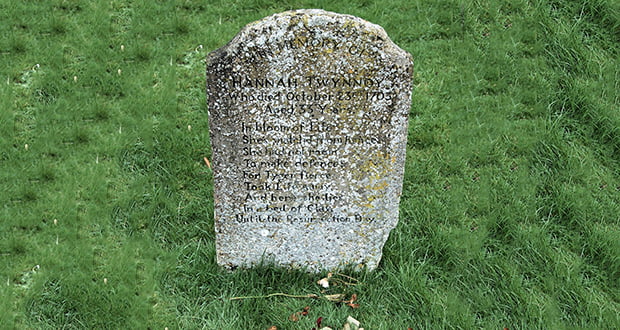26Aochababa

In 1771, a Japanese woman known only as Aochababa (green tea hag) was dissected to compare Chinese anatomical knowledge to the Dutch. The Japanese were astonished to see that the Dutch were correct, and wrote up their findings in a 4 volume text, overturning centuries of Chinese medicine knowledge.
27. Lightning rods were fashion fad meant to protect people from lightning strikes. A woven metal ribbon was placed around a hat, and a small chain made of silver was attached to the ribbon. The chain was meant to run down the back of the dress and drag on the ground. The electricity of a lightning strike to the ribbon would theoretically travel down the chain and into the ground, thus protecting the wearer of the hat. This was a popular Paris fashion trend in 1778.
28. In 1781, a British slave ship named Zong threw over a hundred slaves into the ocean to claim insurance on their death.
29. Charles Byrne (nicknamed as “The Irish Giant”) in 1783 feared that grave robbers would steal and dissect his body after his death. He requested that his coffin to be weighed down and buried at sea. Before the burial, his corpse was stolen, dissected, and his skeleton is still on display in Hunterian Museum in the Royal College of Surgeons.
30. When the first US ship arrived in China in 1785, the Chinese loved the American flag by calling it "as beautiful as a flower". Since then, an informal Chinese name for the United States has been the "flower flag country".
Latest FactRepublic Video:
15 Most Controversial & Costly Blunders in History
31Hanged

In 1787, a man was hanged for deserting and re-enlisting in the British Army 47 times, in order to get the large bounty obtained upon joining the army.
32. In the 1790s, the Guillotine was so popular that toy replicas were being sold to kids to behead their dolls and rodents, and the wealthy had tiny ones on their dining table for slicing bread.
33. Benjamin Franklin tried to abolish slavery in 1790 by petitioning Congress and writing many essays on abolitionism.
34. Orcas Island, famous for its resident pods of orcas, was actually named after Horcasitas, the Viceroy of Mexico, who sponsored an expedition there in 1791. The name “orca” originated in Ancient Rome; therefore “Orcas Island” is probably the most coincidental place name on Earth.
35. In 1799, a boy named Conrad Reed found a 17lb. of rock made of gold in a creek in North Carolina and used it as a doorstop in the family's home for several years. In 1802, Conrad's father, John Reed, showed the rock to a jeweler, who recognized it as gold and offered to buy it. Reed, still unaware of the real value of his "doorstop," sold it to the jeweler for $3.50.
36Benjamin Lay

Benjamin Lay was an 18th century Quaker vegetarian abolitionist who once kidnapped the child of slaveholders temporarily, to show them how Africans felt when their relatives were sold overseas.
37. When vaccines and similar treatment were first introduced in the 18th century, religious leaders condemned them, saying that diseases are sent by God to punish sinners. To try to cure the sinners would be going against God's will.
38. James Price was an 18th-century chemist/alchemist who claimed to be able to turn mercury into gold. When challenged to perform the conversion for the second time in front of credible witnesses, he instead committed suicide by drinking prussic acid (cyanide).
39. Bedlam Asylum was one of the most popular tourist attractions of 18th century London. Visitors paid a penny to watch suffering inmates. Entry was free on Tuesdays.
40. In the 18th century, to discreetly tax rich people more, Scotland, England, and France imposed window taxes based on the number of windows your residence had. To this day you can see many bricked over windows from that time.
41Hannah Twynnoy

The first person in Britain to be eaten by a tiger was Hannah Twynnoy who was a Barmaid working at a pub called the White Lion in Malmesbury in 1703.
42. Charles Domery was an 18th-century soldier known for his immense appetite. During his service, he ate dozens of live cats, pounds of raw meat and grass, and once tried to eat the severed leg of a crew member who was hit by cannon fire before other members of the crew wrestled it from him.
43. Newspapers are so big (broadsheet) because the british government began taxing newspapers in 1712 based on the number of pages a newspaper had.
44. On February 27, 1717, a series of massive snowstorms began in New England. A week later, 95% of the deer population had died and many single-story homes were completely buried.
45. Wig theft was a problem in 18th-Century England, with thieves using children, dogs, and monkeys to snatch the expensive wigs of wealthy people on the street.



